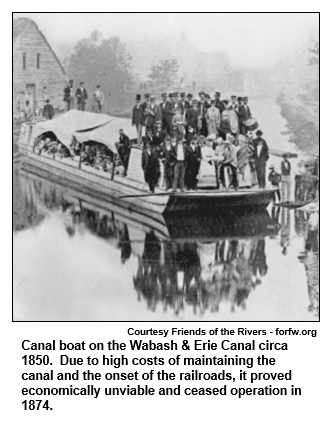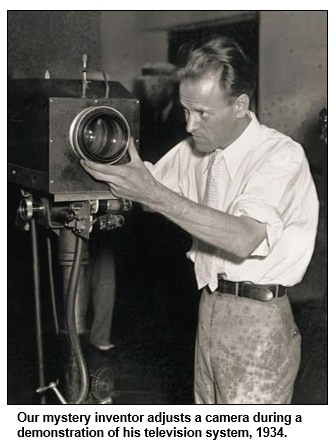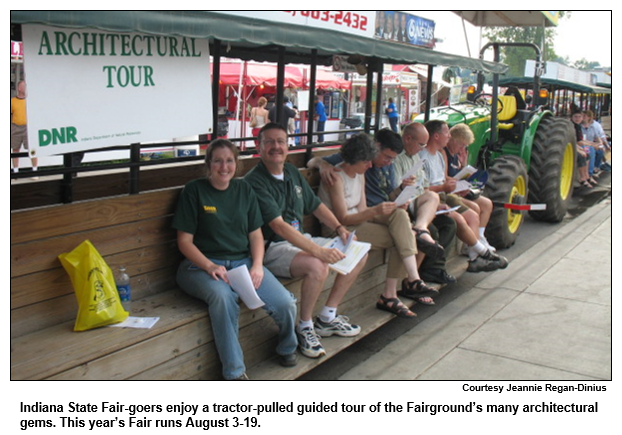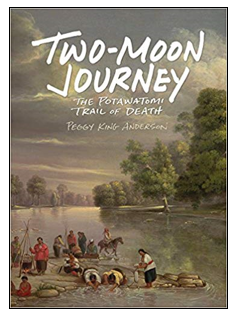Saturdays, noon to 1 p.m. ET on WICR 88.7 FM.
Or listen live from anywhere on WICR Online!
Our call-in number during the show: (317) 788-3314

August 4, 2018
Fort Wayne: riverfront heritage and historic building reuse

The state's second-largest city is located at the confluence of three waterways: the St. Joseph, St. Mary's and Maumee rivers. Against the backdrop of a vibrant revival of the downtown riverfront in Fort Wayne, we will explore the impact of the rivers on the city as well as current initiatives to reuse historic riverfront buildings.

Recently, a replica of a 19th-century canal boat, "Sweet Breeze," was launched for history tours about Fort Wayne's waterways. The canal era in Indiana was brief; the last boat on the Wabash & Erie Canal docked in 1874.
The name of the replica canal boat is a nod to the region's Native American history. Sweet Breeze was the daughter of Little Turtle (circa 1751-1812), the widely admired chief of the Miami Indians based in northeastern Indiana.
Nelson will be joined by two studio guests who will serve as our guides through Fort Wayne's riverfront history and the new ways it's being showcased:
- Allen County historian Tom Castaldi, who writes a history column for Fort Wayne Monthly magazine and hosts "On the Heritage Trail" segments about local history for WBOI-FM Radio.
- And Fort Wayne historian Randy Harter, the owner of Fort Wayne Food Tours, which offers downtown walking tours exploring the city's history, architecture and food heritage. Randy also is the author of several books, including Legendary Locals of Fort Wayne (Arcadia Publishing, 2015) - fellow guest Tom Castaldi is among those profiled in it - and Fort Wayne Through Time, which will be published this fall.
 "Summit City," the historic nickname for Fort Wayne, was derived from its canal heritage. The city was the highest point (or summit) on the Wabash & Erie Canal. Built by manual laborers as a way to transport goods and people, the canal linked the Great Lakes with other canals and, ultimately, the Ohio River.
"Summit City," the historic nickname for Fort Wayne, was derived from its canal heritage. The city was the highest point (or summit) on the Wabash & Erie Canal. Built by manual laborers as a way to transport goods and people, the canal linked the Great Lakes with other canals and, ultimately, the Ohio River.
For several years, the town of Delphi in Carroll County also has been showcasing its Wabash & Erie Canal heritage to visitors. Cruises on replicas of historic canal boats, with costumed re-enactors as guides, are offered at the Wabash and Erie Canal Park in Delphi. Our guest Tom Castaldi helped plan and research displays at the park's canal museum.
In Fort Wayne, historic revitalization efforts underway include the revitalization of a stretch of Columbia Street in downtown Fort Wayne known as The Landing. In February, a major renovation project began there with the goal of reusing historic structures as restaurants, apartments, offices and retailers.

According to Riverfront Fort Wayne, famous landscape architect George Kessler used Fort Wayne's three rivers as the basis for his design of the city's parks and boulevard system in 1912. We explored Kessler's design of the Indianapolis parks and boulevard system on a show in 2010. Kessler, who was based in St. Louis, died in Indianapolis in 1923.
Even today, the St. Joseph River supplies the drinking water for more than 250,000 people in the Fort Wayne metro area, according to Riverfront Fort Wayne.
On a historic bridge over the St. Mary's River, groundbreaking for the first phase of Promenade Park occurred in June 2017. Completion of Promenade Park, which will include a pavilion for public use, is expected in 2019.
History Mystery

According to the book Legendary Locals of Fort Wayne by our guest Randy Harter, the inventor eventually held more than 165 patents. He had moved back to Utah by the time of his death in 1971.
Question: Who was the inventor?
The call-in number is (317) 788-3314. Please do not call in to the show until you hear Nelson pose the question on the air, and please do not try to win if you have won any other prize on WICR during the last two months. You must be willing to give your first name to our engineer, you must answer the question correctly on the air and you must be willing to give your mailing address to our engineer so we can mail the prize pack to you. The prize is a gift certificate to Story Inn in Brown County, courtesy of Story Inn, and two tickets to the Indiana History Center, courtesy of the Indiana Historical Society.
Roadtrip: Indiana State Fair and its history

Guest Roadtripper Jeannie Regan-Dinius, who works in Historic Preservation and Archeology at the Indiana Department of Natural Resources, invites us to join her on a trip to the 162nd Indiana State Fair, which runs August 3-19 this year.

As Jeannie explains, the State Fair played an interesting role in the transportation history of central Indiana. The first electric interurban trolley in Indianapolis, traveling to Broad Ripple from downtown Indy, had a special line to serve fair goers. Also, the Monon Railroad had a siding for cattlemen and farmers to drop off goods at the Fair, as did the Nickel Plate (the diagonal line that in recent years transported history-loving Fair-goers from Fishers and Noblesville).
The Monon built a depot just north of 38th Street (then called Maple Road) in 1922 so passengers from northern and southern Indiana could disembark right by the Fairgrounds. If train history is your thing, take a close-up look at the still-standing Boulevard Station (often referred to as the Monon Depot) via the Monon Trail, which runs along the west side of the fairgrounds.
You can read more fascinating details about the history of the State Fair at the DNR website. Or better yet, tune in to the show and join Jeannie on this history-oriented State Fair Roadtrip!Prizes solicited for History Mystery contest
If your business or organization would like to contribute prizes for our History Mystery contest, we would love to have them! Ideally they fit in a standard mailing envelope, such as coupons or vouchers.
Your organization gets a mention on the air by Nelson, as well as a link to your website on our newsletter and website! If interested, contact producer Molly Head at molly@hoosierhistorylive.org.
Nelson Price, host and historian
Molly Head, producer/project manager, (317) 927-9101
Michael Armbruster, associate producer
Cheryl Lamb, administrative manager
Richard Sullivan, senior tech consultant
Pam Fraizer, graphic designer
Garry Chilluffo, special events consultant
Please tell our sponsors that you appreciate their support!

 Acknowledgments to Monomedia, Visit Indy, WICR-FM, Fraizer Designs, Heritage Photo & Research Services, Henri Pensis, Chris Shoulders, Aaron Duvall, and many other individuals and organizations. We are an independently produced program and are self-supporting through organizational sponsorship, and by individual contribution at the yellow button on our newsletter or website. For organizational sponsorship, which includes logos, links, and credits in the show, contact Molly Head at (317) 927-9101 or email her at molly@hoosierhistorylive.org. And any of our podcasts can be sponsored for a nominal fee.
Acknowledgments to Monomedia, Visit Indy, WICR-FM, Fraizer Designs, Heritage Photo & Research Services, Henri Pensis, Chris Shoulders, Aaron Duvall, and many other individuals and organizations. We are an independently produced program and are self-supporting through organizational sponsorship, and by individual contribution at the yellow button on our newsletter or website. For organizational sponsorship, which includes logos, links, and credits in the show, contact Molly Head at (317) 927-9101 or email her at molly@hoosierhistorylive.org. And any of our podcasts can be sponsored for a nominal fee.
Thank you!
We'd like to thank the following recent, new and renewal contributors whose donations help make this show possible!
- Dave and Theresa Berghoff
- Ann S. Frick
August 11, 2018 - Upcoming
Potawatomi Trail of Death in 1838
One of the most tragic episodes in Indiana history occurred during two months in 1838.
The Potawatomi Trail of Death was the forced removal of more than 840 Potawatomi Indians from their villages in the Twin Lakes region of northern Indiana on a grueling march of more than 660 miles to Kansas. Soldiers initially under the command of Gen. John Tipton enforced the march, during which many Potawatomi - particularly the elderly and young children, including babies - died of illness and exhaustion.
 Beloved Potawatomi leader Chief Menominee and other tribal chiefs were caged in a "jail wagon" during the Trail of Death. The march began near the town of Rochester in Fulton County.
Beloved Potawatomi leader Chief Menominee and other tribal chiefs were caged in a "jail wagon" during the Trail of Death. The march began near the town of Rochester in Fulton County.
We will explore the Trail of Death in advance of the annual event that commemorates it, the Trail of Courage Living History Festival in Rochester. The festival at the Fulton County Museum will be held September 15-16, followed this year by a special caravan for those who want to drive the route of the tragic journey of the Potawatomi from Indiana to Kansas. In recent years, 76 historic markers have been erected along the trail that honor where the Potawatomi camped as they made the forced trek, primarily on foot or horseback; a few were allowed to ride in wagons.
Nelson's guests will include Peggy King Anderson, award-winning author of Two-Moon Journey (Indiana Historical Society Press), a new children's book about the Potawatomi Trail of Death (the book's title alludes to the march's length of two months). Although her book is a work of historical fiction, Peggy thoroughly researched the history of the march and the suffering that the Potawatomi endured. Her late husband, Ken Anderson, was Potawatomi (and probably at least partially descended from those who lived in Indiana); their five children and grandchildren are listed on tribal rolls. Peggy, who is based near Seattle, Wash., will participate in next month's festival and in the caravan.

The Potawatomi defy many of the current stereotypes of American Indians. They lived in dome-shaped wigwams, cabins or rectangular lodges called longhouses, not tepees. Potawatomi men in the 1830s often wore turbans. In northern Indiana, many tribe members were Catholic. A French-born Catholic priest, Rev. Benjamin Marie Petit, learned the Potawatomi language, administered religious sacraments and accompanied the tribe on the Trail of Death.
"He believed that the forced emigration of the Potawatomi was a great injustice, and (he) provided care and comfort on their journey," according to our guest Peggy King Anderson, who features Rev. Petit as a character in Two-Moon Journey. Rev. Petit kept a journal about the Trail of Death, as did Gen. Tipton.
Although their journals and other accounts mention occasional acts of compassion by Tipton's soldiers, they also describe cruelty, including the use of bayonets to prod Potawatomi who walked too slowly. When the caravan came through towns such as Danville, Ill., soldiers forced the Potawatomi to wear ceremonial clothing to create a spectacle for townspeople as the Indians were paraded down city streets.
According to some accounts, more than one third of the Potawatomi fell ill during the Trail of Death, often from typhoid fever.
Earlier in the 1830s, the Potawatomi lived across most of the northern third of Indiana. In central Indiana, the Lenape (called Delaware Indians by white settlers) had been among the primary Native American tribes. During a show in 2014 we explored the Lenape heritage in Indiana, including what has been called the tribe's "forced immigration" in the 1820s to Kansas.© 2018 Hoosier History Live. All rights reserved.
|






